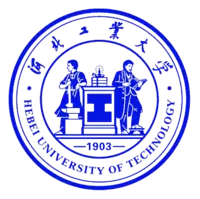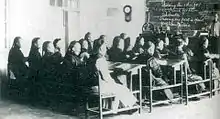Hebei University of Technology
Hebei University of Technology (HEBUT; simplified Chinese: 河北工业大学; traditional Chinese: 河北工業大學; pinyin: Héběi Gōngyè Dàxué) is a public university whose main campus lies in the Guangrong Dao neighborhood of the Hongqiao District in Tianjin, China. It is the first institute of technology in modern Chinese education history. It is among the first group of institutions of higher learning in the national “211-Project” to which priority is given in funding. It is also a Chinese Ministry of Education Double First Class Discipline University, with Double First Class status in certain disciplines.[1]
 | |
| Motto | 勇毅专精 勤慎公忠 |
|---|---|
Motto in English | Diligence, Prudence, Devotion and Loyalty |
| Type | Public |
| Established | 1903 |
| President | Prof. Xu Han |
Academic staff | 2,100 |
| Undergraduates | 17,300 |
| Postgraduates | 5,300 |
| Location | , |
| Campus | Urban |
| Website | http://www.hebut.edu.cn/ (中文) http://eweb.hebut.edu.cn/ (English) |
 | |
History

The institution was established by Yuan Shikai, receiving a royal charter in 1903 as Peiyang Technological School, from Guangxu Emperor. Zhou Xuexi was the first president (Chinese: 总办).[2] The university modeled itself on the famous European and American institutions of higher learning and aimed to rejuvenate China by training qualified personnel with new scientific and technological knowledge. In 1958, after restructuring, institution was renamed Hebei institution of Technology. In 1995, institution was renamed Hebei University of Technology.
Timeline[3]
1903–1949
1903: Founded with the name Beiyang Technical School.
1904: Renamed as Zhili Higher School of Technology.
1929: Renamed as Hebei Provincial Technological Institute.
1946: Renamed as Hebei Provincial Institute of Technology.
1949–1993
1950: Renamed as Hebei Institute of Technology.
1951: Merged with Beiyang University as Tianjin University.
1958: Re-established as Hebei Institute of Technology.
1962: Integrated with Tianjin Mechanical and Electrical Engineering Institute, Tianjin Institute of Chemical Technology as well as Tianjin Construction and Engineering Institute into Tianjin Institute of Technology.
1971: Restored with the name Hebei Institute of Technology.
1994–present
1995: Renamed Hebei University of Technology.
1996: Enlisted as one of the first key universities in the national “Project 211". Successfully completed the three stages of construction.
About Hebei University of technology[4]
Hebei University of Technology (HEBUT) is a key provincial university. It is an important university under the authority of Hebei province which specializes in engineering studies and combines multiple academic areas including technology, science, economics, management and arts. HEBUT has 69 undergraduate programs, embracing a wide range of disciplines including engineering, science, economics, management, art and law. It is composed of 17 schools/, 1 physical-training teaching department and 2 teaching administrative schools. It has 6 state-level disciplines with specific characteristics and 18 province-level representative programs, 2 national key disciplines, 4 province-level advantageous disciplines and 20 provincial key disciplines. There are 42 disciplines authorized to award doctor degrees, 131 disciplines authorized to offer master's degrees or professional degrees. HEBUT is the first engineering-based university to launch MBA program in China. HEBUT is the only university in the province that offers an EMBA education. It offers 9 post doctoral work stations.
Campuses[4]
HEBUT is located in Tianjin, but also has campuses in Langfang. HEBUT covers an area of more than 267 hectares with a construction group area of 870,000 square meters. In the 200-hectare Beichen campus, a 400,000-square-meter construction project has been completed and put into use where, at present, there are more than 21,000 full-time students, including 6,373 post-graduates. The City College which is sponsored by HEBUT has around 16,000 students, with 16,000 more pursuing their vocational and bachelor's degrees through adult education. The school teaching and research equipment is worth 372 million RMB, and there are 1.88 million books in the school library.
International HEBUT[4]
HEBUT has been committed to international cooperation and attaches importance to the development, quality improvement and brand building of educational exchanges. It was qualified by a Chinese government project to award international student scholarships. At present, HEBUT has generated international exchange programs with universities in more than 60 countries and regions including France, the United States, Germany, Russia, Italy, Australia, Great Britain, Finland, Japan, Hong Kong and Taiwan . Over 20 exchange programs are being carried out, which so far have received 500 international students for non-degree education and sent more than 800 students abroad.
Faculty[4]
HEBUT emploees 2474 faculty members. Among them 1365 full-time teachers, 706 of which hold senior professional titles, as well as 682 teachers with doctorate degrees. HEBUT operates team of national technology expertise, 3 state-level teaching teams, 2 innovative research teams with the Ministry of Education, as well as 5 provincial teaching teams.
Research[4]
HEBUT is equipped with 1 national engineering research center as well as 17 provincial and ministerial level research institutes. With the establishment of the HEBUT National Defense Science and Technology Institute, the university obtained a national military-industrial confidentiality qualification. Since 2004, nearly 3000 research projects have been undertaken resulting in around 1500 scientific achievements (160 of which are national key level projects).
Notable people
Alumni
- Translator, Huang Ai
- Chairman of the People's Political Consultative Conference of China, Jia Qinglin
Faculty
- Artist and art teacher, Li Shutong
References
- "教育部 财政部 国家发展改革委 关于公布世界一流大学和一流学科建设高校及建设 学科名单的通知 (Notice from the Ministry of Education and other national governmental departments announcing the list of double first class universities and disciplines)".
- Ed. Chen Dedi (Chinese: 陈德第) (2004). Looking Back a Hundred Years (Chinese: 回眸百年). Harbin: Heilongjiang Renmin Chubanshe. ISBN 7-207-06225-7/K.714, pg 4
- "HEBEI UNIVERSITY OF TECHNOLOGY". eweb.hebut.edu.cn. Retrieved 2020-10-31.
- "HEBEI UNIVERSITY OF TECHNOLOGY". eweb.hebut.edu.cn. Retrieved 2020-10-31.